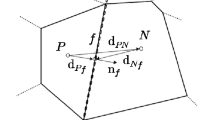Abstract
In this paper, a finite-difference based ENO (essentially nonoscillatory) procedure has been chosen for the direct numerical simulation (DNS) of compressible turbulence. The implementation of the ENO scheme follows the relatively efficient procedure in Shuet al. (1992), but the latter has been modified in the present paper to admit scalar conservation equations and to run on the iPSC/860 Paragon parallel supercomputer. DNS results with our procedure are in excellent agreement with pseudo-spectral and Padé approximation calculations in two and three dimensions. This is the case for a variety of initial conditions for compressible turbulence. The parallel algorithms presented are simple but quite efficient for DNS, with a speedup that approaches the theoretical value. Some of the attractive features include 1) minimum communication whereby a processor only communicates with two neighbors, 2) almost one hundred percent load balancing, 3) a checker-board approach to solve the Poisson equation reduces communication by a factor of approximately 2, and, 4) obtaining turbulence statistics is based on a ‘global collect’ approach, which is implemented to ensure that a single number, rather than a large matrix of numbers, is communicated between processors. The ENO code presented in this paper should be quite useful in its own right, while the parallel implementation should allow the simulation of fairly realistic problems.
Similar content being viewed by others
References
Bailey, D., Barszcz, E., Barton, J., Browning, D., Carter, R., Dagum, L., Fatoohi, R., Fineberg, S., Frederickson, P., Lasinski, T., Schreiber, R., Simon, H., Venkatakrishnan, V., and Weeratunga, S. (1994). The NAS parallel benchmarks. RNR Technical Report RNR940007. March.
Erlebacher, G., Hussaini, M. Y., Kreiss, H. O., and S. Sarkar, S. (1990). The analysis and Simulation of Compressible Turbuelnce.Theoret. and Comput. Fluid Dyn. 2, 73.
Eswaran, V., and O'Brien, E. E. (1989). Simulations of scalar mixing in grid turbulence using an eddy-damped closure model.Phys. Fluids A 1, 3, 537.
Fischer, P. F., and Patera, A. T. (1994). Parallel simulation of viscous incompressible flows.Ann. Rev. Fluid Mech. 26, 483–527.
Givi, P., Madnia, C. K., Steinberger, C. J., Carpenter, M. H., and Drummond J. P. (1991). Effects of compessibility and heat release in a high speed reacting mixing layer.Combust. Sci. and Tech. 28, 33–67.
Ghosh, S., and Matthaeus, W. H. (1991). Low Mach number two-dimensional hydrodynamic turbulence: Energy budget and density fluctuations in a polytropic fluid.Phys. Fluids A 4, 1, 148.
Harrar, D. L., Keller, H. B. and Lin, D. (1991). Parallel computation of Taylor-vortex flows. CRPC Report No. 91-7, Caltech, Pasadena, California.
Harten, A., Enquist, B. S., Osher, S., and Chakravarthy, S. (1987). Uniformly high order essentially non-oscillatory schemes, III.J. Comput. Phys. 71, 231.
Joslin, R. D., and Zubair, M. (1993). Parallel spatial direct numerical simulations on the Intel IPSC/860 Hypercube. ICASE Report No. 93-53.
Kreiss, H., and Oliger, J. (1973). Methods for the approximate solution of time dependent problems. GARP Report No 10. modified ENO schemes.J. Sci. Computing 5(2), 127.
Kida, S., and Orszag, S. (1990a). Enstrophy budget in decaying compressible turbulence.J. Sci. Computing 5(1), 1–34.
Kida, S., and Orszag, S. (1990b). Energy and spectral dynamics in forced compressible turbulence.J. Sci. Computing 5(2), 85–125.
Kida, S., and Orszag, S. (1992). Energy and spectral dynamics in decaying compressible turbulence.J. Sci. Computing 7(1), 1–34.
Ladeinde, F. (1992). Challenges posed for parallel processing on the iPSC/860 supercomputer by DNA schemes for supersonic flows. InParallel Fluid Dynamics 1992. Pelz, R. B., Ecer, A., and Häuser, J. (Eds.), Publ. Elsevier Science Publishers, pp. 253–266.
Ladeinde, F. (1995). Supersonic flux-split procedure for second moments of turbulence.AIAA J. 33(7), 1185–1195.
Ladeinde, F., O'Brien, E. E., Cai, X., and Liu, W. (1995). Advection by compressible turbulence.Phys. Fluids 7(11), 2848–2857.
Lee, S., Lele, S. K., and Moin, P. (1991). Eddy shocklets in decaying compressible turbulence.Phys. Fluids A 3(4), 657–664.
Lele, S. K. (1992). Compact finite difference schemes with spectral-like resolution.J. Comp. Phys. 103, 1, 16–42.
Passot, T., and Pouquet, A. (1987). Numerical simulation of compressible homogeneous flows in the turbulent regime.J. Fluid Mech. 181, 441–466.
Reinsch, K. G., Schmidt, W., Ecer, A., Häuser, J., Periaux, J. (1992). Parallel computational fluid dynamics 1991. Publisher: Elsevier Publishing Co., Amsterdam, pp. 1–200.
Roe, P. L. (1986). Characteristic-based schemes for the Euler equations.Ann. Rev. Fluid Mech. 18, 337–265.
Rogerson, A., and Meiburg, E. (1990). A numerical study of the convergence properties of ENO schemes.J. Sci. Computing 5(2), 151–167.
Sarkar, S., Erlebacher, G., Hussaini, M. Y., and Kreiss, H. O. (1991). The analysis and modelling of dilatation terms in compressible turbulence.J. Fluid Mech. 227, 473–493.
Shu, C.-W. (1990). Numerical experiments on the accuracy of ENO and modified ENO schemes.J. Sci. Computing 5(2), 127–149.
Shu, C.-W., and Osher, S. (1988). Efficient implementation of essentially nonoscillatory shock-capturing schemes.J. Comp. Phys. 77, 439.
Shu, C.-W., and Osher, S. (1989). Efficient implementation of essentially nonoscillatory shock-capturing schemes, II.J. Comp. Phys. 83, 32.
Shu, C.-W., Zang, T. A., Erlebacher, G., Whitaker, D., and Osher, S. (1992). High-order ENO schemes applied to two- and three-dimensional compressible flow.J. Appl. Num. Math. 9, 45–71. Also ICASE Report 91-38 (1991).
Simon, H. D. ed. (1992). Parallel computational fluid dynamics: implementations and results using parallel computers. MIT Press, Cambridge.
Simpson, L. B., and Whitfield, D. L. (1992). Flux-difference split algorithm for unsteady thin-layer Navier-Stokes equations.AIAA Journal 30(4), 914–922.
Sun, X.-H., and Joslin, R. D. (1993). A simple parallel algorithm for compact finite-difference schemes. ICASE Report No. 93-16.
Zeman, O. (1990). Dilatation dissipation: The concept and application in modeling compressible layers.Phys. Fluids A 2(2), 178–188.
Author information
Authors and Affiliations
Rights and permissions
About this article
Cite this article
Ladeinde, F., O'Brien, E.E. & Cai, X.D. A parallelized eno procedure for direct numerical simulation of compressible turbulence. J Sci Comput 11, 179–205 (1996). https://doi.org/10.1007/BF02088815
Received:
Issue Date:
DOI: https://doi.org/10.1007/BF02088815




